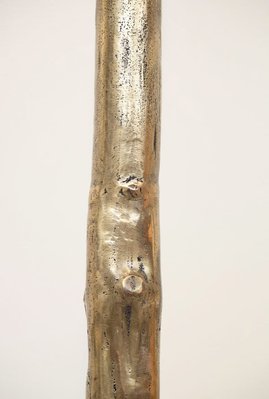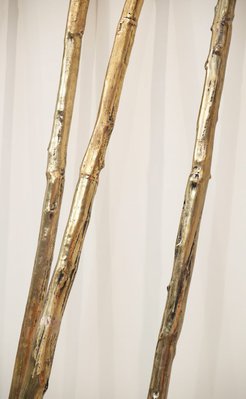Title
The scaffold called the Motherland spews infinite grace
2012
Artist




-
Details
- Place where the work was made
-
Mysore
→
Karnataka
→
India
- Date
- 2012
- Media category
- Sculpture
- Materials used
- cast Indian brass
- Dimensions
-
dimensions variable
:
a - eucalypt, 269 x 7 cm, (irreg.)
b - eucalypt, 255 x 8 cm, (irreg.)
c - eucalypt, 267.5 x 6.5 cm, (irreg.)
d - eucalypt, 271.5 x 6.5 cm, (irreg.)
e - eucalypt, 253.5 x 5.5 cm, (irreg.)
f - eucalypt, 298.5 x 7 cm, (irreg.)
g - eucalypt, 269 x 6.5 cm, (irreg.)
h - eucalypt, 268 x 10 cm, (irreg.)
- Signature & date
Not signed. Not dated.
- Credit
- Viktoria Marinov Bequest Fund 2012
- Location
- Not on display
- Accession number
- 281.2012.a-h
- Copyright
- © Sangeeta Sandrasegar. Courtesy of the artist and Murray White Room, Melbourne
- Artist information
-
Sangeeta Sandrasegar
Works in the collection
- Share
-
-
About
Sangeeta Sandrasegar's practice explores notions of cultural identity, place and belonging through the lens of post-colonialism. Her work to date has consistently engaged with the shadow as a formal and symbolic motif, which she conjures in relation to delicate graphic images produced by cutting away sections of fine paper and textiles. The sculptural installation 'The scaffold called the Motherland spews infinite grace' marks a material departure, inspired by two extended trips Sandrasegar made to India in 2011 to seek out personal connections with her cultural heritage.
During these visits, Sandrasegar was struck by the prevalence of Eucalyptus saplings across various parts of the country, from Bangalore, to Chandigarh to Dehli, known locally as the 'Mysore gum', a legacy of colonial trade and exchange. In recent times, the species has been cultivated for use in the construction industry as a form of structural support for concrete slabs. Upon seeing clusters of these sapling trunks bridging between the floor and ceiling of rooms unfinished buildings, Sandrasegar mused that they functioned "for a brief space in time [as] abstract Australian landscapes"- momentary ruptures to the foreignness of the urban Indian environment.
'The scaffold called the Motherland spews infinite grace' plays on the idea of returning the saplings to their historical point of origin. Working with a traditional sand-floor foundry in Mysore, Sandrasegar cast the poles in brass, a material that alludes to traditional Indian sculpture, architecture and decorative arts. Smelted from votive ornaments and pots and pans, the eight trunks are imbued with an incongruous sense of preciousness and permanence. Imported into Australia in this form, the objects embody the processes of transferral and translation that are implicit to globalisation and intercultural exchange.
-
Exhibition history
Shown in 3 exhibitions
The Other's Other, Artspace, Woolloomooloo, 09 May 2012–17 Jun 2012
The scaffold called the Motherland spews infinite grace, Murray White Room, , 22 Jun 2012–28 Jul 2012
Continental Shift: Contemporary art and South Asia, Bunjil Place Gallery, City of Casey, Warren, 22 Jun 2019–22 Sep 2019
-
Bibliography
Referenced in 4 publications
-
Mark Feary, Column 10, 'The other's other', pg. 101-108, Sydney, 2012, 105, 106, 138 (colour illus.). Note: only one scaffold is pictured on pg. 138
-
Dan Rule., Broadsheet Media, 'A reflection of home', Melbourne, 02 Jul 2012. Viewed 19.09.2012, http://www.broadsheet.com.au/melbourne/arts-and-entertainment/article/reflection-home
-
Sangeeta Sandrasegar., http://sangeetasandrasegar.blogspot.com.au, 'The scaffold called the Motherland spews infinite grace', Melbourne. Viewed 19.09.2012, http://sangeetasandrasegar.blogspot.com.au/2012/07/the-scaffold-called-motherland-spews_26.html#!/2012/07/the-scaffold-called-motherland-spews_26.html
-
Natalie Wilson and Anneke Jaspers, Foundation Newsletter #22, 'Curators' and coordinators' report: Australian art', pg. 6-7, Sydney, Jun 2013, 7.
-
